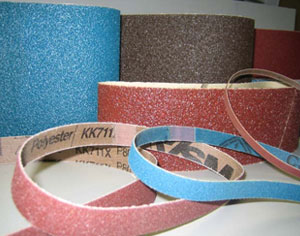
Resources
- Home
- About Abrasive Sanding Belts
- Abrasive Sanding Belt
- Abrasive Sanding Belts FAQ
- Abrasive Sanding Belts Reviews
- Best Abrasive Sanding Belts
- Cost Of Abrasive Sanding Belts
- Guide To Using Abrasive Sanding Belts
- Recommended Abrasive Sanding Belts
- Types Of Abrasive Sanding Belts
- Where To Buy Abrasive Sanding Belts
Types Of Abrasive Sanding Belts
There are a broad range of different types of abrasive sanding belts that can be used to perform a variety of sanding tasks. The abrasive sanding belts that you choose for your sanding project will depend primarily on what you are trying to do. When it comes to selecting types of abrasive sanding belts, you should first familiarize yourself with the grit of the sandpaper needed. It is therefore important to learn a bit more about what grit is and how it will influence the sanding project that you intend to accomplish.
How grit influences the types of abrasive sanding belts
Grit is basically a term that applies to the number of sharp particles placed in any particular belt. The lower the grit of a specific sanding belt, the coarser and rougher the material will be. Lower grit means that you will be able to sand the material down to the size you require, but it will be difficult to make the wood or coat smooth with lower grit. As such, if you need to mainly smooth out a piece of wood or other material, then you should stick to finer grits.
Common types of abrasive sanding belts
- Aluminum oxide sanding belts are very popular, and the reason for this is that aluminum oxide particles sharpen themselves through fragmentation as a result of heat and pressure effects during sanding. This results in a sanding belt that is very durabke and will last for a considerably longer amount of time than many other types of abrasive sanding belts.
- Garnet is another type of sandpaper that has been used extensively. It is less durable than aluminum oxide and as such you can expect it to wear down a lot quicker. It is considered to be quite useful for finishing off a particular wooden piece, because it smooths out surfaces quite well without too much scratching.
- Silicone carbide is quite strong and can be used to effectively cut metal or harder materials than wood.
- Cermic abrasives are among the more expensive types of sanding materials out there, and they are typically used for the quick roughing down of wood edges for quick wood removal.
The first step in any sanding project is to determine the type of abrasive sanding belts that will be required to get the job done to the exact specification that you require. It is not too difficult to figure out this information. Abrasive sanding belts are available in many different grits, and chances are that you might be needing more than one abrasive sanding belt to successfully complete your project. For example, if you only need to sharpen down the edges of a piece of wood, then you would likely only need low grit abrasive sanding belts to achieve this. On the other hand, if you need to smooth out the surface of the wood afterwards, then finer abrasive sanding belts might be required.
Choosing your abrasive sanding belts from a store
Since there are quite a few types of abrasive sanding belts out there, understanding the grit you require is basically the most important part of the search process. Some projects might require you to "work through grits", which means you will need to use a variety of different grits starting from coarse to fine. Once you know exactly what types of abrasive sanding belts you need, you can move on to searching for a store that sells them. Depending on the complexity of your project, you might find it easier to make use of industrial grade abrasive sanding belts, which are sometimes harder to come by.
